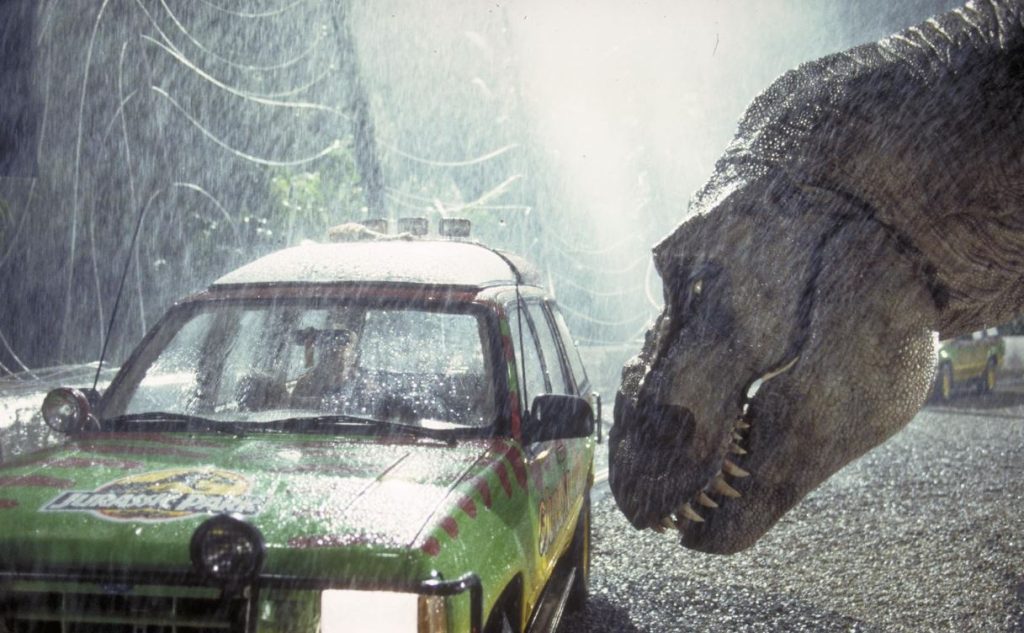
Michael Crichton was a creative powerhouse and so successful across a variety of fields that even though he’s dead I still feel like a sniveling booger on the underside of his boot. A prolific writer, he penned nearly thirty novels, many of which were turned into films such as the groundbreaking blockbuster Jurassic Park, the Sean Connery/Wesley Snipes dud Rising Sun, and the fascinatingly skewed workplace drama Disclosure.
Not only that, but this six-foot-nine, non-practising M.D. came up with the screenplay for the massive (but crap) mid-90s hit Twister and created the pretty watchable TV show ER (well, up until Clooney left). A workaholic, he was a man whose fertile mind bubbled with prescient ideas, but crucially had the knack of conveying such ideas in an accessible, stimulating way. Pleasingly non-pc, he also upset feminists, environmentalists, captains of industry and the racially sensitive.
Crichton’s driving concern was technology and its effect on people, as demonstrated by one of his earliest novels to get the big screen treatment, The Andromeda Strain. However, despite being built on the decent concept of an extra-terrestrial virus causing our blood to powderise, it gets bogged down in technical detail. It’s a long 130 minutes that prefers capturing scientific accuracy to providing good ol’ entertainment. No matter, because it still became the twelfth biggest hit of 1971, enabling Crichton to go on and become the writer-director of six flicks of vastly differing quality. The first was the wonderful Westworld.
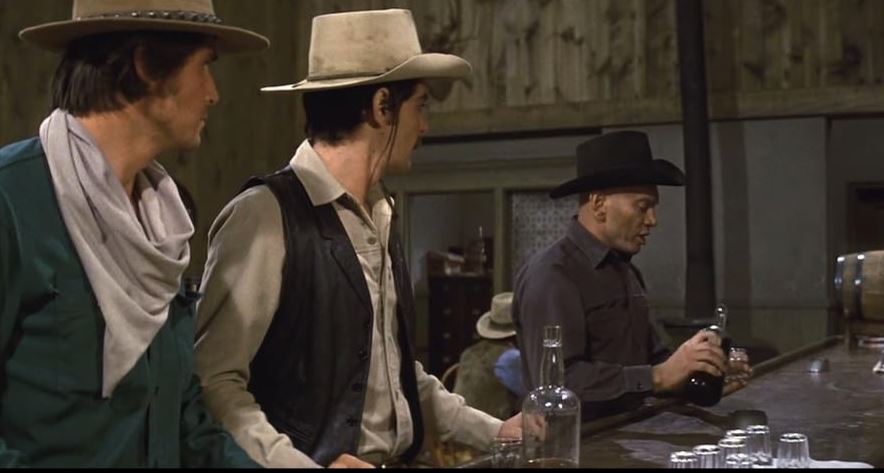
The schmuck-like Peter (Richard Benjamin) and the more assured John (James Brolin) are a pair of mates taking a very expensive holiday courtesy of a company that has built three adult theme parks on the same site. The two pals have plumped for Western World, a place based on frontier life in the 1880s populated by lifelike androids. Hence, it doesn’t matter if you shoot ’em, fuck ’em or throw ’em down the stairs because anything goes in this hedonistic playpen. It’s the ‘vacation of the future, today.’ Behind the scenes, however, the parks’ technicians are becoming edgy about the escalating number of small malfunctions in the robots’ behavior.
Not that our novice cowboys have the slightest notion of this fly in the ointment. Shortly after arrival, Peter gets to test his mettle when Yul Brynner deliberately bumps into him in a saloon, spilling his drink. “Get this boy a bib,” the surly newcomer tells the barman. “He needs his mama.” A gunfight then plays out in which Peter, of course, triumphs. Peter can barely believe what he’s done, his brain obviously zinging with endorphins. Before long he’s having a great time at a bordello and gleefully kicking in doors to shoot the baddies…
Westworld is well thought-out, its terrifically understated cast helping create a believable world. It’s also timeless in how it taps into machismo, power fantasies and sex. It doesn’t matter whether vacationers (who may be frustrated wimps in their real lives) spend time in Western World, Medieval World or Roman World because they’ll still be able to marry a princess, defeat a gladiator, be sheriff for the day or just kill lots of people. It’s the ultimate form of wish fulfillment, the sort of energizing environment from which you stride out of three inches taller.
Aided by a wry sense of humor, Westworld also has a strange sadness in its shots of the abused androids being carted away in the middle of the night, only to be repaired and sent out to suffer the same fate the next day for human amusement. It’s here that Crichton ensures meat on the bone by raising the specter of AI and the possibility of machines learning to overcome their masters’ control. Brynner, who memorably plays a vengeful, black-clad gunslinger with advanced tracking capabilities, is essentially a prototype of Arnie’s Terminator eleven years later. Overall, Westworld possesses a streamlined simplicity that the subsequent HBO show refused to replicate, taking the product of Crichton’s fantastic imagination and royally overcomplicating everything.
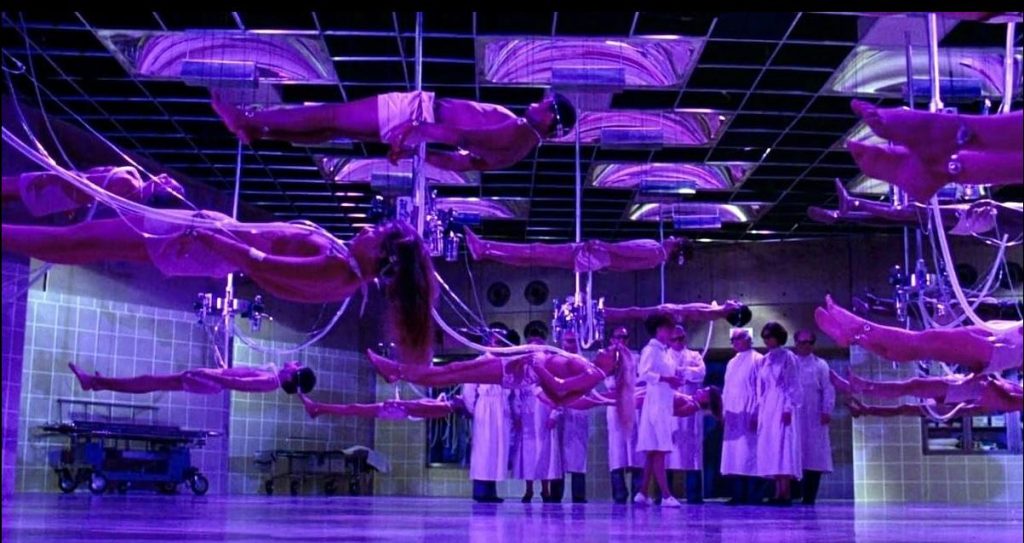
Crichton showed he was no flash in the pan by helming another technology-infused masterpiece five years later in the form of the truly creepy Coma. [Editor’s Note: Based on a novel written by Robin Cook]Whereas Westworld was very much a man’s affair, Coma offers a plucky, appealing heroine in Geneviève Bujold. An excellent example of a Strong Female Role, she gives us a nuanced portrait of an intelligent woman possibly afraid of intimacy as she makes her way in a male-dominated field. Her head-bumping encounters with her colleagues, especially the condescending, politics-obsessed Michael Douglas and the all-powerful Richard Widmark, generate compelling drama.
Bujold plays a doctor at a Boston hospital who turns into a human bloodhound after a good friend’s routine surgery results in rubbery brain time. The trail leads her to the sinister Jefferson Institute, a low-cost facility for comatose patients. Coma boasts lots of memorable sequences, but the eerie scene in which she wanders among the institute’s suspended coma patients lost in their silent, eternal netherworld is a doozy.
Crichton put his medical knowledge to good use in Coma, packing just about every frame with telling details. The whole thing is built on the ghastly idea that a hospital, the one place where you have the right to expect the highest standard of ethics and care, is instead somewhere that wants to exploit you to the most merciless degree. Like Westworld, Coma is partly a warning against greed. The theme parks in Westworld should have been shut down long before the slaughter began whereas Coma also reveals its nefarious practices to be fuelled by the god of profit.
With these two flicks, Crichton showed that although he was a workmanlike director, he knew how to pen an absorbing screenplay. Chuck in terrifically convincing casts and you’ve got movie gold. The same can’t be said of his next two examinations of technology’s dark side. Both 1981’s Looker and 1984’s Runaway suffer from silly scripts, a significant flaw amplified by actors who are also a good few notches down.
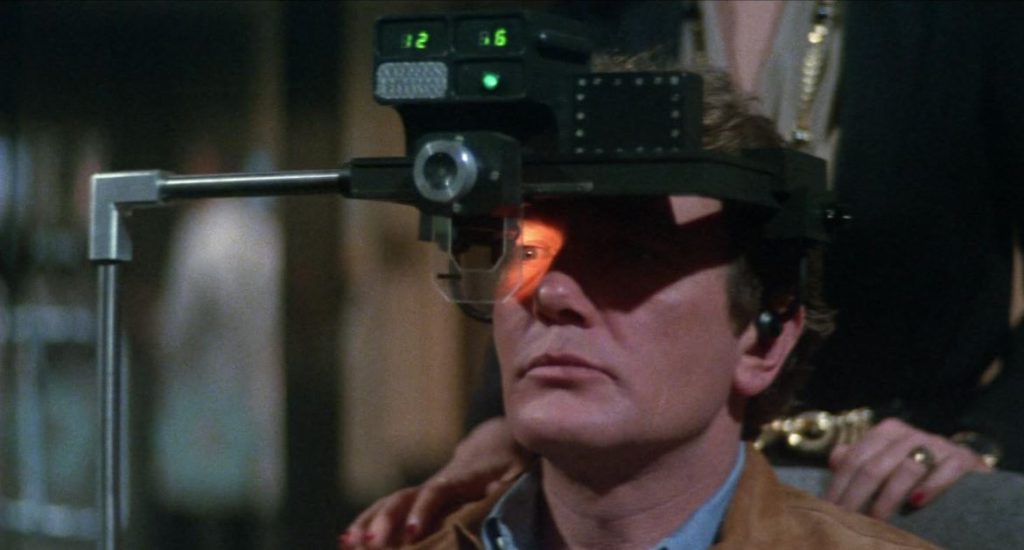
Now as I earlier implied in my appraisal of the amusingly bonkers Eyes of Laura Mars, I don’t exactly burst into tears when those self-absorbed nonentities known as models get offed. Looker taps into my yen for this sort of thing by immediately having a busty model dozily getting entangled in a curtain and falling off a hi-rise balcony.
This slightly less than tragic death introduces Looker’s plot in that the former patients of renowned Beverly Hills plastic surgeon Dr. Larry Roberts (Albert Finney) are all mysteriously dying after undergoing ridiculously trivial procedures to make them perfect, such as changing the width of a nose by 0.2mm. The only link between the deaths is Digital Matrix, a business they all did TV commercials for. Roberts starts investigating, helped by some incredibly lax security.
Looker depicts a company using ‘hypnotic light pulses’ to drastically increase the effectiveness of TV commercials i.e. get people to buy stuff. This is fertile ground (and tapped into again in Halloween III a year later when an advert was put to much more sinister use) but Looker grows sillier and sillier. Its main problem is that Digital Matrix has no reason to kill the girls, leaving everything constructed on waterlogged sand. Things are not helped by an over the hill Finney failing to convince whenever he has to do any action stuff e.g. somehow winning a fight when he can’t even see his opponent.
Westworld and Coma took things seriously, but Looker is more tongue-in-cheek, ending with a daft final sequence mixing comedy and murder in a TV studio. Crichton was never averse to recycling plots, but Looker feels like he ripped out elements of Coma and stuck them into a superficial rehash about our obsession with appearance and the evils of advertising. The computer graphics stand up well, but it’s a shame someone like James Coburn has such a sketchy part that he can’t make an impression. Oh well, at least the nudity-splashed Looker isn’t dull while the idea of replacing actors with computer simulations is probably already a reality.
Looker flopped, but it’s a lot better than Crichton’s follow-up. Runaway is a lame dog, the perfect example of a movie dealing with rogue technology in which the technology depicted is not yet advanced enough to convince. You could nitpick the inconsistencies in Westworld and Coma if you wanted, but Runaway is not only full of holes but features an annoying child, poor dialogue and Gene bloody Simmons. The musician’s attempt to follow in the villainous shoes of Brynner and co merely results in a man who glowers, scowls and glares, perhaps because he knows he’s recorded something even less worthy than the average KISS album.
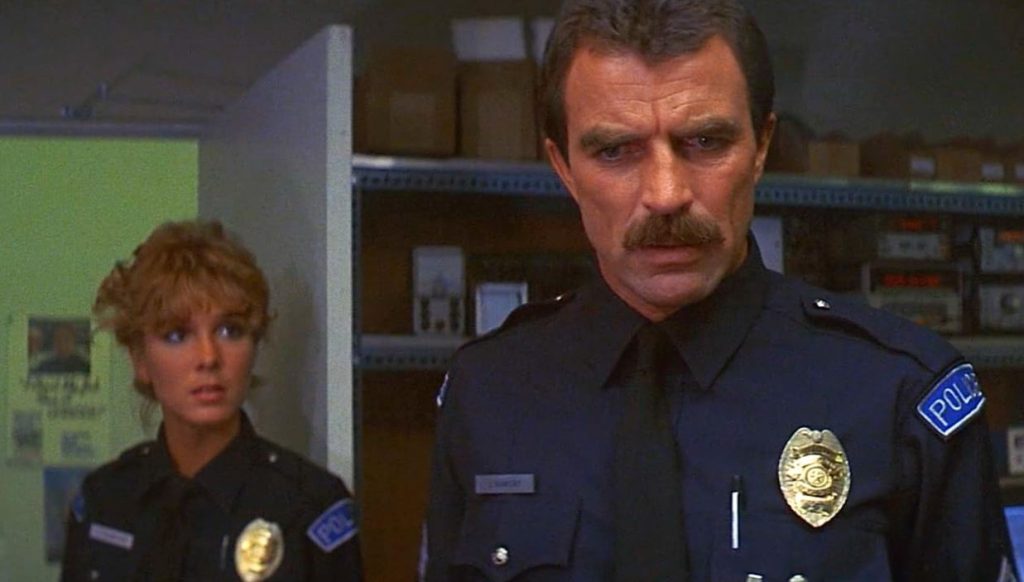
The tension-free Runaway is about a near-future police squad set up to tackle the commonplace problem of malfunctioning, possibly dangerous robots. All good, but this essentially means having to watch Tom Selleck and his foot-wide tash try to look wary of foes that are nothing more than slow-moving boxes on wheels. He’s not exactly dealing with the T-1000, you know? Even the robot security guards running amok in 1986’s cheesy Chopping Mall were more convincing. Just look at the opening scene. Here Tom is dispatched to deal with an agricultural pest controller in a cornfield. The thing is about nine inches high and looks like a radio controlled Tonka toy blowing a fuse. Why the human workers have to call in the cops to deal with it is mystifying. Poor Tom. He might as well be trying to convince us he’s up against a reckless fridge or a malevolent overhead projector.
Things reach their nadir when a knife-wielding house robot goes berserk and kills two women. Tom has to get inside and rescue a baby, except the machine’s now got a Magnum .357! And a TV crew is interfering. Oh boy, it’s an unbelievably shit sequence in which Tom, his tash and a bizarre codpiece incompetently exercise zero control over the crime scene. After Crichton tantalizes us with shadowy glimpses of this killer droid, we eventually get to meet a six-inch high, wobbly box with a centrally positioned, somewhat inflexible-looking claw arm. How the hell did it manage to stab anyone? Disappointingly, it doesn’t get to mutter any Dirty Harry-style lines before Tom dramatically zaps it with a laser. He then emerges with the rescued baby as a gathered crowd cheers, conveniently ignoring the dead TV cameraman that Tom ineptly let into the house. The whole segment begs the question: Why haven’t the cops designed their own robot to neutralize faulty robots instead of risking lives?
After Runaway also flopped, Crichton’s directorial career never recovered. Coma and Westworld were glorious, but his swansong proved ignominious: he took charge of a 1980s Burt Reynolds flick.
Leave a Reply